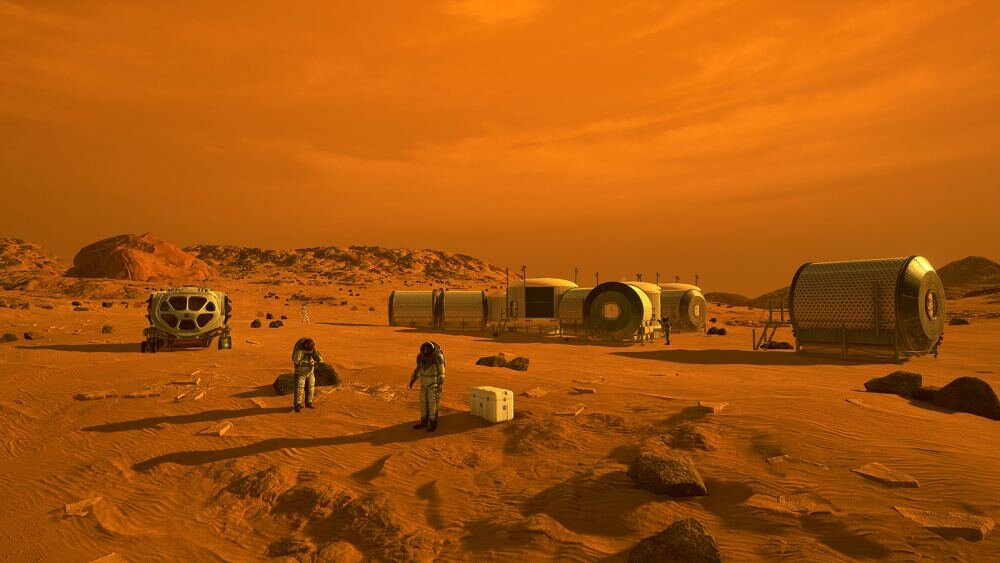Need to go to Mars? Nice, now all it is advisable to do is plan a mission. Work out the place to land, what to carry, and the way you are going to reside there within the months (or years) between favorable return home windows. All this might be decided by the supply of essential sources you may must survive.
That is going to sound like a journey brochure, however the pink planet affords a lot to take a look at for a primary human mission. There are canyons, plains, craters, volcanoes, and polar areas. So, the place do you begin first? It will rely upon what kind of mission you need to accomplish. A easy “plant boots and the flag” journey will not require loads of infrastructure.
A extra complicated mission goes to want extra infrastructure for habitats and science stations. Basically, you may land, construct a habitat, discover the close to neighborhood, set up a science outpost, and survive the radiation and environmental challenges of Mars. Your Mars “to-do checklist” contains bringing provides and building materials to get began. Then, it is advisable to take into consideration survivability, increase your outpost, doing exploration, and—crucially—having a launch web site for a return to orbit and again to Earth.
Determining the place to go on Mars is a mechanical and planetary puzzle with loads of shifting elements. And, people have by no means launched a long-term crewed mission to a different planet in historical past. So, it is all new to us.
Mars pioneers want all the things
Historically, people have moved round our personal planet Earth trying to find new locations to discover and reside. Early settlers and explorers moved into new areas ready with some provides. Nonetheless, they may at all times depend on native sources of meals, water, and shelter, too. Not so true on Mars for the primary explorers. They’re going to need to carry all the things they want (at first), together with air, water, meals, and machines to assist extract native sources for ongoing habitation.
Clearly, water is crucial. With out it, you will not get to remain very lengthy or get a lot carried out. Mars does not have any flowing throughout the floor. However, it does have hidden sources. First, there are apparent ice deposits on the poles, together with provides of water ice. Second, there’s loads of water ice hidden beneath the floor. Third, there are hydrated minerals. Of those three decisions, getting water from hydrated minerals would be the most troublesome. These have water locked away inside, like clays. You may want specialised equipment to extract that water. Drilling for subsurface ice is likely to be simpler within the quick time period. Fixing the water entry downside provides you sources for rising meals, having a drink, and manufacturing and propulsion. So, choose a web site with good water entry.
The landing site ought to ideally be at a low altitude (higher for human habitation) and never be a dust pit. That stuff on Mars is finely floor and extremely poisonous with perchlorate compounds. It should get into all the things (not good for machines) together with human lungs (not good for well being). The dustier a touchdown spot, the tougher it will likely be to perform a helpful mission and preserve the people secure.

Energy to the Martians
Okay, so you’ve got acquired a web site close to water sources, it is dry however not too dusty, what else do you want? Energy. Your habitats, equipment, and automobiles are going to want juice. Solar energy may appear to be a good selection, and it’s in use now on the landers and rovers at the moment in place. If you wish to maximize solar power, you may land close to the equator, the place days are longer and also you get extra daylight. Nonetheless, you may in all probability additionally need to carry alongside some kind of nuclear energy machine. It is not topic to adjustments within the climate and is a long-term, regular supply.
One other benefit of near-equatorial touchdown websites is increased common temperatures. Mars is a chilly place, even on the warmest days. Close to the equator, temperatures can get as excessive as round 20°C (70° F) and a minimal of -73° C (-100°F). Land a bit farther north, within the mid-latitudes, and you can face temps as little as -148 F (-100 C) through the winters. And, neglect concerning the poles for long-term habitation. They’re going to be a lot colder, year-round. Keep in mind that you need to reside safely and preserve your tools heat, so the equator makes loads of sense. You may get extra solar warmth there and save in your gasoline utilization.
Transferring round Mars
So, you find yourself close to the equator, however you need to discover the remainder of the planet? That requires automobiles and people require gasoline and upkeep. There’s loads of discuss utilizing in-situ useful resource utilization (ISRU) not simply to get water to drink, however to make gasoline. And, superior ISRU amenities ought to enable Mars inhabitants to cycle floor rocks (clays, for instance) for water and different supplies. So, the supply of helpful floor supplies (and water) will dictate your precise touchdown web site.
Ultimately, as soon as you’ve got established a house on Mars, you may need to get on the market and science the you-know-what out of Mars. You may be learning the local weather, and geology, and perhaps on the lookout for proof of historic (and possibly long-gone) life. The primary research areas might be proper close to your touchdown web site since they’re going to be simple to get to. However, ultimately, scientist-explorers will head to distant locations, like Valles Marineris, the Jezero Crater web site, the volcanoes, and ultimately the poles. These targets would require extra energy and extra sources.
What about leaving the planet?
Sooner or later, people will need to get again to Earth, perhaps carry again samples to ready labs, go to kin, carry different Marsnauts onboard, and so forth. How do you get off the planet as soon as you’ve got been there some time? You might carry alongside gasoline on your launch to Mars orbit. That is seemingly what the first mission or two will do. However, dragging gasoline out and in of a gravity effectively (even one as mild as Mars’s) is dear. You’ll be able to resolve a few of that by making your individual gasoline on-planet.
In case your touchdown spot is close to the equator, you’ll be able to benefit from the planet’s spin price there to offer the launch automobile a lift into space. That’ll offer you some gasoline financial savings. For longer-term missions, you may be making gasoline from native sources, however you may nonetheless need to economize on fuel usage.
So, it appears like for all standards, touchdown close to the equator goes to be your best option, notably for a primary human “landfall on Mars.” And, that is what mission planners are serious about now, for actual, in each space company and some company places of work all over the world. It is a complicated endeavor. Deciding on a web site is the primary order of enterprise, and as you’ll be able to see, it is not easy. Finally, the most effective spot for people to land on Mars might be as secure and resource-rich as planners can choose. Then, it is as much as the people who go there to make all of it work—and present the remainder of us the wonders of the red planet.
Offered by
Universe Today
Quotation:
The place are the most effective locations to land people on Mars? (2022, December 16)
retrieved 16 December 2022
from https://phys.org/information/2022-12-humans-mars.html
This doc is topic to copyright. Other than any honest dealing for the aim of personal research or analysis, no
half could also be reproduced with out the written permission. The content material is offered for info functions solely.





